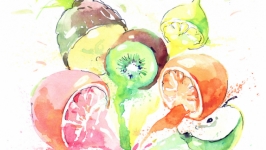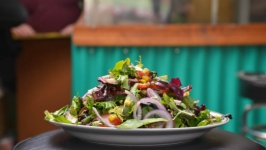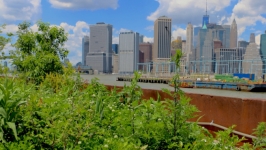Rescuing Leftover Cuisine
Have you ever stood in line at a deli or takeout restaurant just a few minutes before closing, eyed the sandwiches and pastries in the display and wondered: What are they going to do with all that food? Queens native Robert Lee has been working to answer that very question for the last five years. In 2013, he started Rescuing Leftover Cuisine, a nonprofit organization that is fighting food waste, one meal at a time.
Every year in the United States, 40% of food is thrown away. The issue is magnified when juxtaposed with the number of families who are food insecure. According to the USDA, food insecurity is defined as “the limited or uncertain availability of nutritionally adequate and safe foods or limited or uncertain ability to acquire acceptable foods in socially acceptable ways.” Worldwide, there are 805,000,000 people who are food insecure, and 41.2 million of them live in the U.S. According to a press release from Hunger Free America, one in three Bronx children are living in food insecure households; from 2013 to 2015, one in five New York City children lived in food insecure homes. It’s no question that food waste and food insecurity in the United States are major problems, but thanks to the efforts of people like Lee, his team and a cohort of volunteers that come from all walks of life, it is not insurmountable.
Lee started Rescuing Leftover Cuisine (RLC) after learning that existing food rescue organizations in New York had minimum pound requirements. “There were restaurants that really wanted to donate their food but couldn’t because they were being turned down from the organizations that had existed,” Lee recalls. So RLC was born in this niche—rescuing the food that even food rescue organizations couldn’t reach.
With RLC’s unique model, anybody can sign up to do a food rescue. Instead of using more traditional food rescue models, like performing pickups with large trucks or outsourcing transportation, RLC relies on its fleet of volunteers to perform pickups whenever they can—on their commute home from work, on their lunch break, or whenever they have a free half-hour during the week—and deliver them to homeless shelters and food pantries across the city. Using a web application, RLC’s partner organizations like restaurants, hotels and catering companies can notify volunteers when they have an excess of food available for pickup. Using this model, Lee encourages an approach that does not contribute to greenhouse gases while rescuing food.
So, what can you do? Above all, Lee wants you to know that you can make a difference when it comes to fighting food waste. “We’re growing, and we can’t continue to grow without help. […] Our philosophy—the reason we got started—is because we believe that every small bit counts,” Lee said. “Even small amounts of time can help, even small amounts of donations can help quite a bit, and to sustain our growth and to continue to make more and more of an impact, partner with more and more restaurants and rescue more and more food, we need all the support we can get.” With food rescues taking place in over 16 cities across the country, there is no doubt that the small efforts of volunteers are making a huge difference. Headquartered in New York City, RLC’s presence in the Bronx is limited, but they are hoping to expand and connect with more food donors within the borough. They currently work with Fordham University and Dunkin Donuts, which delivers leftover doughnuts to POTS (Part of the Solution), a nonprofit organization that provides food and other social services to low-income Bronx residents.
Lee’s ultimate goal is to have every single restaurant working with a food rescue organization. “I think everyone should know that food waste is a multi-faceted, difficult and complex problem, but it’s not [impossible] to overcome,” Lee says. “And there are many different ways to target the different types and amounts of food waste […] So obviously at the consumer level, each of us can do something about the three meals we eat every day, and ensure that we reduce food waste there. But there are also other ways [to help], for example, like volunteering with Rescue Leftover Cuisine.” Since its inception, RLC has collected over 1.7 million pounds of food. Lee hopes to hit another million in just one year.
To join the effort to fight food waste visit rescuingleftovercuisine.org and sign up for a food rescue.









